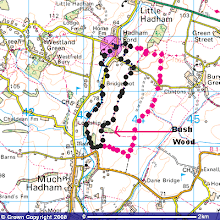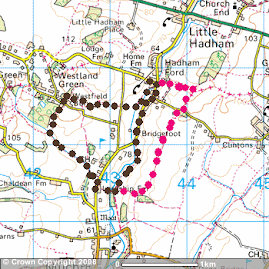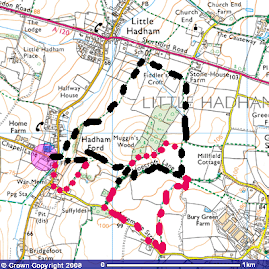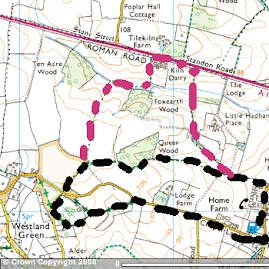With the remarkably high temperatures and no rain until the 27th July, this month has been my best on record for numbers of moths.
On 30th June I had recorded 3309 and by 31st July this total had increased to 8114. Therefore: 4805 moths had been logged in 31 days, an average of 155 insects a night.
In terms of species, 30th June saw me having recorded 171 macros and by the end of July this had risen to 234, 63 new macros whilst micros had risen from 111 to 180, an increase of 69! Remarkable figures for 31 days of running the garden 125W Skinner trap each night. I also ran the portable 15W actinic trap at 9 sites around the parish on 9 nights.
Week 1: Sunday 1st - Saturday 7th July
Cydalima perspectalis was taken on the 1st, a now annual visitor to the trap, having taken the 2nd for Herts in 2012. A Maple pug in the garden was a good moth for that site whilst a
Ostrina nubalis was only my 3rd record, taken in the garden on the 3rd. The 4000th moth for the year, a Dwarf Cream Wave was taken this night, too.
A Dingy shears was a new for the parish records, also garden on the 3rd before a much awaited Small elephant hawkmoth made its first parish appearance on the 6th, again to the garden. On the 7th I took another new for parish record of a
Marasmarcha lunaedactyla, my 327th micro for Little Hadham.
 |
| Small elephant hawkmoth |
 |
| Beautiful Golden Y |
 |
| Scalloped oak |
Week 2: Sunday 8th - Saturday 14th July
The records kept coming, with a new for parish Kent black arches from Westland Green on the 8th, along with 11 moths new for the year. At home that evening a Sycamore was a first for the parish.
The following night a Barred red got on to the parish list and this was followed on the 12th by another new record:
Buccaltrix bechensteinella. This had been attracted to the portable trap set on a footpath that crosses the local golf course and placed under grey willow.
An Uncertain on the 10th was the 5000th moth of the year and a Dark umber from the garden on the 12th was the 350th moth species for me in 2018. On the 13th I was checking field guides to identify another new moth for Little Hadham, a
Metalampra italica. A quick check of county records showed this to be a rapid coloniser of Herts, so not as rare as I had anticipated.
 |
| Kent black arches |
 |
| Lesser spotted pinion |
 |
| Ypsolopha sequella |
Week 3: Sunday 15th - Saturday 21st July
This week began with a new record in the garden trap: Cream bordered green pea and a rarely seen this year,
Nomophila noctuella . The 6000th moth was taken on the 16th, a Riband Wave. On the 20th the garden trap gave up an all time record of 214 moths of 94 species, including just 2 new year records:
Ypsolopha scabrella and lime specked pug. The 21st saw just one new year record, an
Agapeta zoegana.
 |
| Ypsolopha scabrella |
 |
| Agapeta zoegana |
 |
| Nomophila noctuella |
Week 4: Sunday 22nd - Tuesday 31st July
A
Ypsolopha vittella from a local unmanaged woodland (Suffyldes Wood) on the 22nd was another new parish record in a good haul to the heath trap, whilst at home the same night I took a
Pyralis farnalis, another new record. The 400th moth species of the year, a
Aspilapteryx tringipennella was taken on the 23rd as was the 7000th moth for the year, a Dunbar. A twin spotted wainscot was a good surprise new moth on the 25th at home and the following night I ran the trap in an oak and hornbeam wood where
Lathronympha strigana was new for the records. Upon arriving home in the early hours I checked around the garden trap and noted another new one, Gypsy moth. The final new for parish record was last night and probably the best moth of the year, a Gold spot. Not too many records of this well marked insect for Hertfordshire, so a great end to a busy month!
The Gold spot constitutes the 736th moth species for the whole of the parish, a not inconsiderable total, but one that will soon be past 750 I suspect, especially if the warm and dry conditions continue into August and beyond. The 8000th moth, an
Eudonia mercurella came on the 30th
 |
| Ypsolopha vittella |
 |
| Gold spot |
 |
| Jersey Tiger, one of 2 taken on the 26th |




















































































